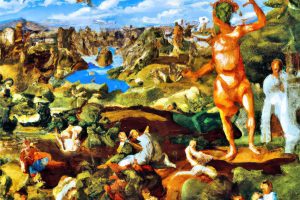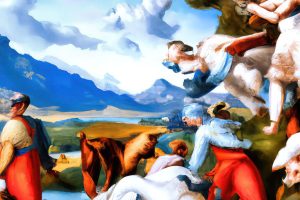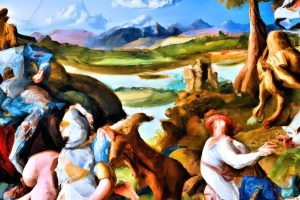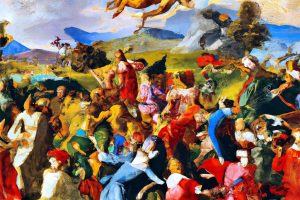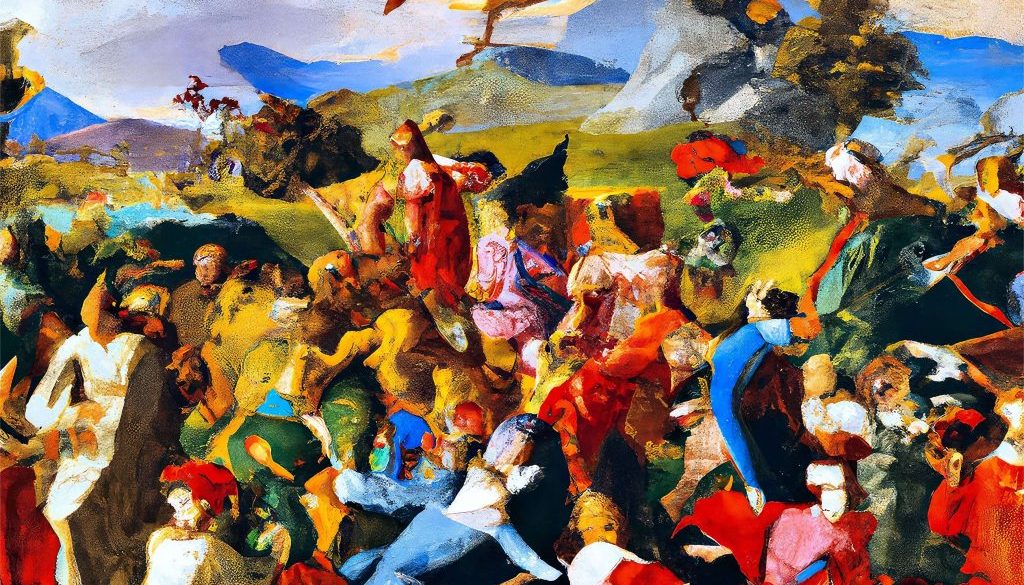
Uncertain Myths:
Confused Visions for Hypertech Times (2023-24)
Mythological themes have been central to artistic storytelling for millennia. Contemporary art, however, has so far struggled to engage with these ancient narratives in a way that feels relevant to our times – too often, either ignoring these classical sources altogether or treating them as mere raw material to be deconstructed and reassembled into derivative or ironically empty pastiches driven by a desire for novelty, for shock value, or simple commercial success, rather than by a commitment to exploring the human condition and our place in the world.
My artworks, originated by human-led AI-mediated dialogue, with imagery then manually reworked, digitally manipulated by hand, and printed on large-scale canvas, aim to offer a fresh perspective on the role of myths today. At the heart of these pieces is a recognition that our world has become fractured by tech and that the traditional frameworks of morality, religion, society and culture are no longer sufficient to navigate our increasingly complex, hyper-connected existence.
These pieces combine a deep understanding of (and respect for) tradition with a willingness to question its relevance and go beyond its boundaries. By offering new ways of exploring timeless dilemmas and pushing the physical limits of what is possible, technology now allows us to create art that is both of our time and conversing with the past – in an age of uncertainty and confusion when our moral, aesthetic, and intellectual compasses seem to be spinning out of control, these visual allegories offer a sense of grounding and connection to something greater than ourselves and open new perspectives to human imagination.
Gallery
Click on the thumbnails to view larger images
Process
Although partially generated through AI-mediated adversarial dialogue, these artworks are not simply random patterns or noise but are created with intention and purpose, mixing LLMs’ output with meticulously handcrafted processes based on traditional techniques.
I begin by producing a large number of partial visual elements through complex dialogue with AI LLMs based on a pre-defined dataset of visual and textual materials (some my own, some sourced from external libraries and repositories).
However, these resulting images are not used simply as they are uncritically. Instead, they are re-edited, manipulated, retouched, combined, re-mixed and transformed manually using various digital tools, in a process that is human-led and guided by a singularly human artistic vision.
To the resulting “master” image, a proprietary synthetic custom digital texture layer is then added (this is the result of a manual process of edition of diverse forms of digital noise, some from the LLMs’ output – it neither reproduces pixelation nor attempts to mimic painterly brushstroke – it is an entirely different kind of texture, only visible at 1:1 scale, as it is lost on low-res images on screen). This adds depth and complexity to the flat digital surface.
At the end of the process, each final image is giclée printed on large-scale (47″x47″) archival-grade Hahnemühle Canvas 340 g/m2 , finished and varnished by hand, to add physical texture, signed and authenticated. Original digital files are then destroyed – so that each artwork becomes a single unique physical object derived from combining contemporary technology with centuries-old printing techniques and materials.
Using AI in my work is no different from using any other tool or medium. Just as a painter uses paintbrushes and synthetic pigments to produce their art, I benefit from AI technology and digital tools to create mine. Most crucially, how is this different from the way that a Renaissance artist like Raphael worked within his huge workshop, instructing his apprentices to mix colours and block-paint basic shapes from a previously sketched scene on canvas (based on visual “recipes” derived from also previously defined iconology), and having his most skilled assistants add details, with the master only providing, if at all, further instruction and finishing touches to complete the work thus “industrially” produced at scale?
About Miguel Ripoll
Generative AI and digital art pioneer, technologist and polymath Miguel Ripoll started experimenting with combinatorial algorithms and creative code back in 1999 – his early digital artworks (exhibited in major institutions like the Reina Sofía Museum in Madrid, the Akademie der Künste in Berlin and the Cervantes Institute) are now in the permanent collection of the Design Museum in Barcelona – but he became frustrated by the limitations of the technology available at the time, and decided to pause artistic practice entirely.
For the last two decades, instead, he has worked at the intersection of art and tech as an expert in the design and coding of digital interfaces for complex information systems for top universities (Yale, Princeton, Columbia, Berkeley, Stony Brook), prestigious cultural organisations (Qatar Foundation, King Hassan II Fund, The Mellon Foundation, and the American Historical Association), and government agencies in Europe, the Americas and the Middle East. He has also lectured at universities in Europe and the US: UCL, Columbia, Lund, Valencia, Alicante, Tarragona and the IESE. His commercial work (digital, print, multimedia, film, and theatre design) has been featured in books and magazines all over the world.
Focused full-time on artistic production again since 2021, Miguel continues to explore complex LLMs as a tool for art production of hand-crafted phygital works that question and subvert long-established themes and traditions of artistic praxis.
View full series “Confused Visions for Hypertech Times” at:
